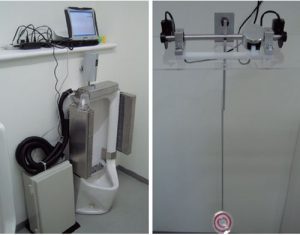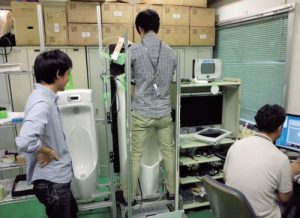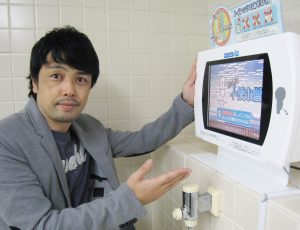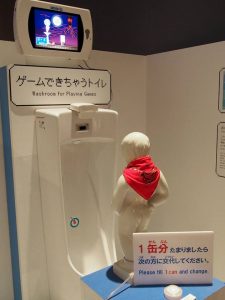|
History
The development of Toylets began in 2006. The idea was born during a discussion about how to incorporate games into the daily life to make people feel closer to games. Arata Jumonji, the creator and chief director of the development team, said, “When you were a child, you would draw pictures on snow with your urine, or aim for the ball-shaped disinfectant in the urinal. Maybe you were playing games unconsciously. This may not be understood by women, but I’ve always thought of it as the first controller that boys hold in their hands.”.
With that in mind, the team decided to build a game that would detect the flow of urine to control a game. While this might seem trivial, the sensor needed to differentiate the flow of urine from the flow of water when the toilet was flushed and the movement from body parts that would be in front of the sensor. To achieve this Sega collected the urination data from more than 1,000 people.
In 2008, the first prototype was installed in the men’s restroom at Sega (Ota Ward, Tokyo). The initial reaction was very positive, but they quickly realize that there was no clear market for it. At this point, Sega had been out of the home video game console for a while now, meaning that Sega had no sale channel outside their arcade one. As this device was aimed at commercial facilities to entertain customers, it didn’t fit in Sega’s existing distribution model. This was a serious issue, one that the team needed to solve for the Toylets to be a commercial success. The team almost gave up many times as, without clients, there was no need for this technology. But Sega never shies down from a challenge. They managed to take over the Karaoke parlor by storm with the release of the Prologue 21 in 1999, they could do it again with the Toylets. They just needed the right angle. It was not long before the team realized that the screen could also be used to display advertisements, which was a very enticing feature to propose to commercial users.
In August 2010, Sega decided to demonstrate their game to the prestigious FOOD STYLE Japan Exhibition (which was formerly known as the Izakaya Industry Exhibition) in Tokyo. To demonstrate the product, Sega had modified a garden fountain of the Manneken Pis (a cherub peeing) for the cherub to start peeing when a button was pressed. The team named the statue Shonta and he was the star of the event. People interest was piqued, but no serious inquiries were made. Still, there were a few companies that showed interest. The question became, how could Sega get them to buy? The development team came up with a plan. They set up screens similar to the one of the Sega Toylets in pachinko parlors in Tokyo and conducted a survey at the toilet exit. They displayed four types of food products on both the Sega Toylets screen and in a paper advertisement, to examine the difference in recognition. The results were favorable: 51% of people who saw the Toylets remembered all four types, compared to 15% of people who saw the paper advertisement.
 |  |  |
| Toylets early prototype | The development of Toilets | Machida Hirotaka, development team producer |
 | ||
| Toylets being display at the National Museum of Emerging Science and Innovation in 2014 |
The test proved to the development team that their product could have a real impact when it comes to advertising product, so they decide to put it to the test in a Izakaya (a type of informal Japanese bar that serves alcoholic drinks and snacks) in Tokyo in the New Year period. Before the test, the store was resistant to displaying menus in the restrooms, but they were pleased with the result with the added benefit of attracting more young customers who came to play the games. The test delivered result quickly, with advertised menu items being ordered 2.2 times more in the two weeks of the test.
The result was presented to the Sega executive, which finally gave the go-ahead. And just when everything finally started to take shape, the great East Japan Earthquake occurred on March 11th. With the need to conserve electricity, selling a product that was essentially a video game console for the toilet didn’t seem to be the right move. The project was again on the verge of being canceled, but the Izakaya industry started to support the disaster-stricken areas by selling sake from the Tohoku region, which convince Sega to continue with the project, with one small change: adding a “power-saving mode” function.
With the final blessing from Sega, the team started the tremendous task of creating a commercially viable version of the product. So far, the prototype was too costly with a price tag ¥300,000 and was too heavy. The weight needed to be under 3 kg in order for the walls of the restrooms to hold up. Eventually, the weight was reduced to 2.9 kg. The final  model would have a speed sensor and dual sensor that would act as a motion sensor and a infrared reflective senior.
model would have a speed sensor and dual sensor that would act as a motion sensor and a infrared reflective senior.
Release
The Sega Toylets were first pre-release in the Yoronotaki izakaya chain in October 2011 which created a buzz around the product (see the picture on the right). On November 21, 2011, the console was officially released alongside eight games (each costing ¥10,000). While the product definitely created a lot of buzz, its adoption was very slow and the cost was a major reason. While Sega boasted that installing the Toylets had many benefits such as increased sales and cleaner bathroom (as peeing outside the toilet wouldn’t count toward your score), the return on investment was hard to achieve, especially if your establishment had many urinals.
By the end of May 2014, there was only 420 Toylets consoles installed in 250 locations. While the main market was still restaurants and amusement facilities, Sega also had some success in hospitals and medical facilities and were aiming to expand into unexplored business types. Sega also tried to reach out to home users by making the Toylets available for home use as well.
There were also some inquiries from overseas which Sega would have loved to accommodate. But going overseas meant that the game needed to be localized, which was too much of an investment with the low sales they had so far. This being said, at least one game (Bukkake Battle! Hana Kara Gyuunyuu) ended up being localized in English and was displayed in South Korea. On top of that, other company such as Captive Media were already developing interactive urinal game for the UK market, which could have been another reason to grow the home market before venturing outside Japan.
Demise
By 2016, the sale of the Toylets hadn’t improved significantly and Sega decided to pull the plug. Sales of the Toylets ended definitely in May 2016 while customer support remained available until March 2021.
But, while the Toylets were discontinued, it didn’t stop Sega to feature them in Yakuza Kiwami 2 (December 7, 2017). Starting in Chapter 3, you can access the ToyLets from the restroom door in Club SEGA where you can plan either Milky nose or The North Wind and the Sun… And Me.
Games
Eight games were developed for the Sega Toylets. Each came on a USB stick and cost ¥10,000.
- Milky nose: Battle of the bosses is similar as Milky nose, but instead of “fighting” the CPU, you are playing against the previous Toylets user.
- The same seems to apply to Save it! Manneken Pis, although this haven’t been confirmed.
 |  |  | |||
| Hana Kara Gyuunyuu 鼻から牛乳 (Milky nose) [VIDEO] | Hana Kara Gyuunyuu: Banchou Battle 鼻から牛乳: 番長バトル (Milky nose: Battle of the bosses) [VIDEO] | Dokitsu! Boufuu Keihou Hatsurei ドキッ!暴風警報発令 (The North Wind and the Sun… And Me) Box #: XKT-1979-0003 USB #: MDA-U0030 | |||
 |  |  | |||
| Graffiti Eraser | Panel Quiz Chou Nyo-ryoku パネルクイズ超ニョ〜力 (Panel Quiz Super Nyo~ryoku) [VIDEO] | Nyounai Checker 尿内チェッカー (Urine Checker) [VIDEO] Box #: XKT-1979-0005 USB #: MDA-U0032 | |||
 |  | ||||
| Tamero! Shoubengozou 溜めろ!小便小僧 (Save it! Manneken Pis) [VIDEO] Box #: XKT-1979-0001 USB #: MDA-U0028A | Tamero! Shoubengozou Deluxe 溜めろ!小便小僧 デラックス版 (Save it! Manneken Pis Deluxe Edition) [VIDEO] | ||||

